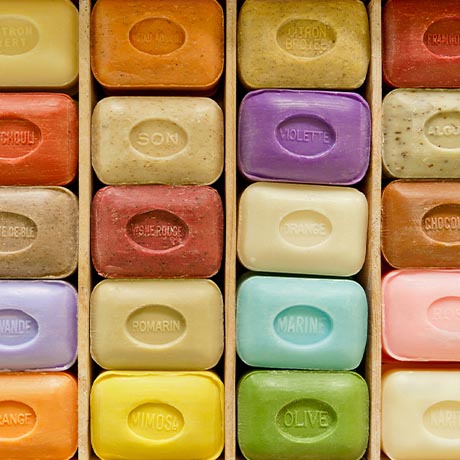Toilet soaps

Toilet soaps are obtained from soda soaps by introducing additives and a fragrance. Toilet soaps also include soaps without additives and fragrance. There are two types of soap: toilet soaps and toilet soaps for children. Toilet soaps for children should be characterized by increased requirements in relation to some quality parameters, e.g.. less free caustic alkali content, limited content of unsaturated fatty acids, and therefore less rancidity, color uniformity throughout the mass, slightly less foaming. Baby soaps should not be colored.
The mainstay of toilet soaps are high-quality pure solid fats and oils. A typical toilet soap matrix should contain: tallow or highly hardened fats in quantity 50-70%, lard or low-hard fats 10-20%, bright rosin 0,5-2,0%. Substances are added to toilet soaps, which improve their usability in terms of customer expectations. Belong to them: essential oils, dyes, oily substances, – moisturizing or slightly moisturizing the skin, substances that reduce the clarity of soap, increasing durability, having a special effect on the skin, substances supporting the washing ability of soaps and others.
The most commonly used ingredients of currently produced toilet soaps are:
• surfactants: the most common sodium salts of tall oil, coconut oil, palm kernel oil with the possible addition of potassium salts of these oils;
• fragrance composition;
• dye;
• moisturizer (rehydrating) the skin: glycerine, allantoin (they easily soak into the skin, making it smooth and soft);
• lightly greasing agent (added in small amounts): Palm oil, avocado fruit oil;
• greasing agent: lanolin (natural wax obtained from sheep wool grease - has properties similar to the secretion of sebaceous glands, found in human skin);
• antioxidant (durability enhancing agent);
• a substance that reduces the transparency of soap: titanium dioxide (titanium white), less often zinc oxide (zinc white);
• substances that have a special effect on the skin: antibacterial substances, cleansing and caring, soothing symptoms of irritation - most often these are natural plant extracts, coconut and citric acids (citric acid has special whitening and astringent properties);
• salt (determines the brittleness of the soap);
• other substances, np.: improving washing abilities (sodium carbonate), improving other useful properties of soap (zinc stearate);
• water.
Popular soaps produced on the basis of sodium salts of fatty acids are: Palmolive, FA, Cleopatra, Aloe, CD, LUX i inne. They are characterized by an alkaline reaction. The use of these soaps by people with sensitive skin can lead to skin irritation and allergic reactions. To improve the dirt removal ability, especially at lower temperatures and lowering the pH value, some of these soaps are mixed with small amounts of synthetic surfactants.
At the same time, soaps are produced, in which the content of synthetic surfactants in relation to sodium salts of fatty acids in the soap is much higher. These soaps, due to the presence of neutral or slightly acid detergents, have a reaction similar to neutral, therefore they are often labeled and recommended as "for sensitive skin" or "neutral pH" soaps.
Such soaps, thanks to the much greater washing capacity of detergents compared to sodium salts of fatty acids, they remove dirt more effectively, but also a protective grease-wax coating, protecting the skin from drying out, peeling and sterilization. Therefore, these soaps should contain significant amounts of moisturizing and greasy substances, which soothe the intense action of the detergent. This type of soaps includes soaps: Dove, LUX for sensitive skin, Palmolive 2 in one, Camey.